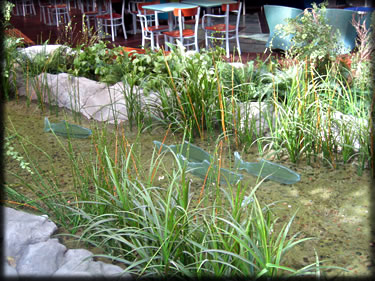

The International Terminal’s Pacific Passage features many aboriginal elements for visitors traveling between Canada and the U.S. Larry Goldstein

Recent YVR Awards
![]() Rated second favorite airport in the world by Condé Nast Traveler magazine, 2008 Readers choice awards.
Rated second favorite airport in the world by Condé Nast Traveler magazine, 2008 Readers choice awards.
![]() Airports Council International’s 2009 global airport survey of international passengers: YVR rated #5 in the world (15 to 25 million passengers category).
Airports Council International’s 2009 global airport survey of international passengers: YVR rated #5 in the world (15 to 25 million passengers category).
![]() In 2024 Vancouver International Airport (YVR) has reclaimed its position as the best airport in North America, according to rankings from the Skytrax World Airport Awards, based on a survey of over 12 million international passengers. YVR is the only facility to receive Best Airport in North America 14 times. YVR is also ranked No. 17 in the world by Skytrax, out of the world’s top 100 facilities in 2024.
In 2024 Vancouver International Airport (YVR) has reclaimed its position as the best airport in North America, according to rankings from the Skytrax World Airport Awards, based on a survey of over 12 million international passengers. YVR is the only facility to receive Best Airport in North America 14 times. YVR is also ranked No. 17 in the world by Skytrax, out of the world’s top 100 facilities in 2024.
By Alison Gardner, Editor, Travel with a Challenge
Over 20 years, I have passed through YVR – Vancouver International Airport – on Canada’s west coast many times. Whether on a domestic or international flight, the ever-growing collection of art and architectural showpieces in mammoth size or miniature has something new to offer, something to surprise and delight, or something to greet with the familiarity of an old friend. In all my world travels, I have encountered no other airport that even begins to replicate this thoughtful, inspiring space – effectively an enormous art gallery through which more than 22 million people pass each year.
A full-time curator, whose position was first created by the Vancouver Airport Authority in 1994, takes her mandate very seriously to create originality and inspiration “on the fly”, working in tandem with architectural and interior design experts equally dedicated to making YVR both distinctive and award-winning rather than a predictable shopping and eating environment with little or nothing to feed the soul and inspire the mind. The Authority, with its community-based Board of Directors, is a not-for-profit organization that reinvests all earnings into airport development and improvements. Refreshingly, investing in the artistic side of YVR is a consistently high priority.

Entering the Customs Hall in the International Terminal, the world’s largest Coast Salish Spindle Whorl, titled “Flight”, is a focal point carved in red cedar by Susan A. Point. Alison Gardner

On the International Departures level, a 114,000-litre aquarium showcases 850 indigenous sea creatures near a massive indoor creek, all celebrating West Coast nature Coast. Larry Goldstein

Anyone who has visited British Columbia appreciates the strength of its spectacular natural beauty, natural resources and distinctive aboriginal cultures. These are the elements and unique sense of place deliberately showcased in this artistic airport, although there are also some wonderfully whimsical art pieces on display to do nothing more than bring a smile to the face of the harried traveler.
Most visibly, the spectacular contemporary aboriginal art has driven the artistic vision for an airport set against a dramatic backdrop of ocean and mountains. YVR houses the largest collection of Northwest Coast native art in the world.
Arriving at the International Terminal, visitors heading into the Customs area are overwhelmed by towering 5.5-meter/19-foot red cedar “Welcome Figures”, colorful 5-meter-high aboriginal weavings hung as banners, and an enormous 5-meter diameter cedar Spindle Whorl carved by a Vancouver native artist to depict the theme and spirit of flight.

These striking five-meter tall hangings were produced by five Musqueam Coast Salish native weavers working together. Alison Gardner
At the heart of the International Terminal, the bronze cast, six-ton Jade Canoe is the focal point of YVR’s art collection. Created by Canada’s most acclaimed aboriginal artist, Bill Reid, it has been hailed by art critics around the world as one of the most significant sculptures of the 20th century. Placing this imposing Haida Gwaii art work, fully accessible to all, at the center of an airport instead of in a museum is a bold statement in itself, with visitor photo ops numbering in the thousands each day.
More recently unveiled, The Pacific Passage awaits passengers arriving in Vancouver from U.S. destinations. Travelers enter through a traditionally-constructed post and beam longhouse doorway, emerging into a Northwest Coast world, complete with the sights and sounds of a sandy beach and lapping water, a 12-metre carved and decorated whaling canoe, and a spectacular thunderbird sculpture soaring overhead. “Am I really in an airport?” is a thought that immediately comes to mind!

The YVR Art Foundation fosters the development of Northwest Coast native art and encourages its display in public buildings. Alison Gardner
Some design elements throughout the airport are more subtle such as ceiling lights and huge sweeps of custom-designed carpet each representing logs that commonly jam together at odd angles in the rivers and coastal inlets around BC’s forestry communities. Don’t forget to look up and down as you hurry to or from your gate!

Even YVR’s carpet design depicting log booms on the nearby Fraser River and the light fixtures throughout the airport reflect the natural resources of the West Coast. Alison Gardner

YVR’s International Terminal hosts a “Pacific Coast” relaxation area with a plant-lined creek, dozens of exquisite glass salmon, artwork and a large west coast sea-life aquarium. Alison Gardner
Drawing inspiration from the natural beauty of the province, YVR’s International Terminal also features an indoor creek with running water, plants, logs and intriguing glass-sculpted salmon sprinkled through the stream-bed. The area is surrounded by cafés, a full restaurant, shops, comfortable (non-airport) seating and original artwork. A large, 114,000-litre aquarium showcasing some 850 indigenous sea animals serves as its Pacific West Coast centerpiece. This is my favorite relax-and-decompress zone between plane flights, another place to completely forget you are in an airport.
In 2016, Vancouver International Airport became the first airport in Canada to implement a program that provides an expedited airport process for families and individuals living with autism. The YVR Autism Access Sticker is a self-identification tool for individuals living with autism that can be placed on boarding passes. The sticker ensures an expedited airport process through screening and customs, and better communicates the specific needs of passengers to airport employees.
As Canada’s second busiest airport, YVR, www.YVR.ca, welcomed about 24.9 million passengers in 2023, representing 63 airlines serving 100 destinations. On the technical side, it is among the most modern and efficient in the world. Yet, it is the heart-side of the airport that defines its character and makes it a pleasure to pass through again and again with the anticipation of new art to be enjoyed with each visit.
Alison Gardner is a travel journalist, magazine editor, guidebook author, and consultant. She specializes in researching vacations throughout the world, suitable for people over 50 and for women of all ages. She is also the publisher and editor of Travel with a Challenge Web magazine. Email: alison@travelwithachallenge.com.
